Introduction
When someone says ‘Pitbull,’ what’s the first mental image that pops into your head? For many, it’s an image shaped by headlines, stereotypes, and fear—a “dangerous” dog bred for aggression. But what if everything you’ve been told about Pitbulls is wrong? The truth is, these dogs are among the most misunderstood breeds on the planet. Behind the myths lies a loyal, affectionate companion that, when raised with care, can thrive in families—even those with kids.
Let’s tackle the elephant in the room: the idea that Pitbulls are inherently aggressive. This stereotype has persisted for decades, fueled by media sensationalism and a lack of understanding about the breed’s true nature.
But here’s what most people don’t know: Pitbulls were once known as “nanny dogs” in early 20th-century America, trusted to watch over children. Their strength and protective instincts were seen as assets, not liabilities. So, what changed? The answer lies not in the breed itself, but in how society has shaped its reputation.
In this blog, we’re digging deeper to answer the burning question: “Are Pitbulls good with kids?” Spoiler alert: The answer isn’t a simple yes or no. Like any dog, a Pitbull’s behavior depends on a mix of factors, including training, socialization, and individual personality.
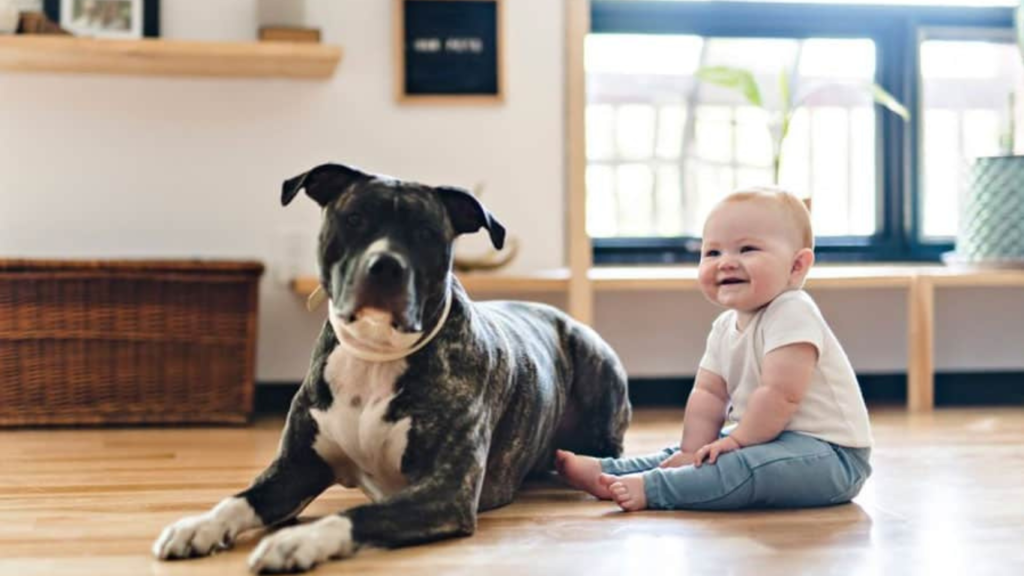
We’ll explore how responsible ownership plays a starring role in shaping a Pitbull’s temperament and why labeling an entire breed as “dangerous” does more harm than good. You’ll hear heartwarming stories of Pitbulls who’ve become beloved family members and learn practical tips for ensuring safety and harmony at home.
But let’s be clear—this isn’t about painting Pitbulls as perfect angels. Every dog, regardless of breed, has unique traits and needs. The key is understanding how to nurture their best qualities while addressing challenges head-on.
Whether you’re a parent considering adopting a Pitbull or simply curious about the breed, this guide will give you the facts, dispel the myths, and help you make informed decisions.
By the end, you might just see these so-called “aggressive” dogs in a whole new light—as goofy couch potatoes, patient playmates, or even protective guardians of the little ones they adore. Let’s get started!
Understanding Pitbull Temperament
When discussing whether Pitbulls are good with kids, it’s essential to start by understanding their true nature. Pitbulls, a term often used to describe breeds like the American Pit Bull Terrier and Staffordshire Terrier, have a complex history.
Originally bred in the 19th century for tasks like farm work and companionship, these dogs were valued for their strength, intelligence, and loyalty. Over time, misconceptions about their temperament overshadowed their natural traits, but a closer look reveals why many families consider them loving, devoted pets.
Breed Overview
The term “Pitbull” isn’t a single breed but a category that includes several closely related dogs. The American Pit Bull Terrier, for instance, is known for its athleticism and confidence, while the Staffordshire Terrier often exhibits a slightly calmer demeanour. Both breeds share a common ancestry rooted in working and companion roles.
Historically, they were trusted around children, earning the nickname “nanny dogs” in some communities. This reflects their innate desire to bond with humans and protect their families. However, their muscular build and misunderstood reputation have led to unfair stereotypes.
Natural Traits
Pitbulls thrive on human connection. Their loyalty and affection are unmatched—they’re often described as “people-oriented” dogs who form deep bonds with their families. Many owners report their Pitbulls being gentle and patient with kids, often seeking out opportunities to play or cuddle.
Their eagerness to please makes them highly trainable, especially when socialized early. Positive reinforcement techniques work wonders, as these dogs respond best to patience and consistency. Like any breed, their energy levels vary, but daily exercise and mental stimulation help channel their enthusiasm into healthy behaviours. A well-raised Pitbull is often a goofy, affectionate companion who adores being part of family activities.
Myth vs. Reality
The most persistent myths about Pitbulls—like the idea of “locking jaws” or inherent aggression—have been repeatedly debunked. Veterinarians and animal behaviourists confirm that Pitbulls have no unique physical mechanism in their jaws; their bite strength is comparable to other medium-sized breeds. As for aggression, studies show no breed is inherently violent.
A dog’s behaviour is shaped by factors like upbringing, training, and environment. Pitbulls raised with love, structure, and socialization are as safe around children as Golden Retrievers or Labradors. Sadly, media sensationalism has skewed public perception, but real-world examples of Pitbulls serving as therapy dogs or family pets tell a different story.
In conclusion, labeling Pitbulls as unsuitable for kids ignores their true temperament. Like any dog, they require responsible ownership—proper training, socialization, and care. When given these, Pitbulls often shine as loyal, playful, and protective family members. The key lies in judging individual dogs by their actions, not outdated stereotypes.
Are Pitbulls Good With Kids? Understanding the Key Factors That Determine Behaviour
The question of whether pitbulls are good with kids isn’t about the breed itself but about the individual dog and the factors that shape their behavior. Like any dog, pitbulls aren’t born inherently “good” or “bad” with children—their temperament depends on how they’re raised, trained, and treated. Let’s break down the four key elements that play the biggest role in determining how a pitbull interacts with kids.
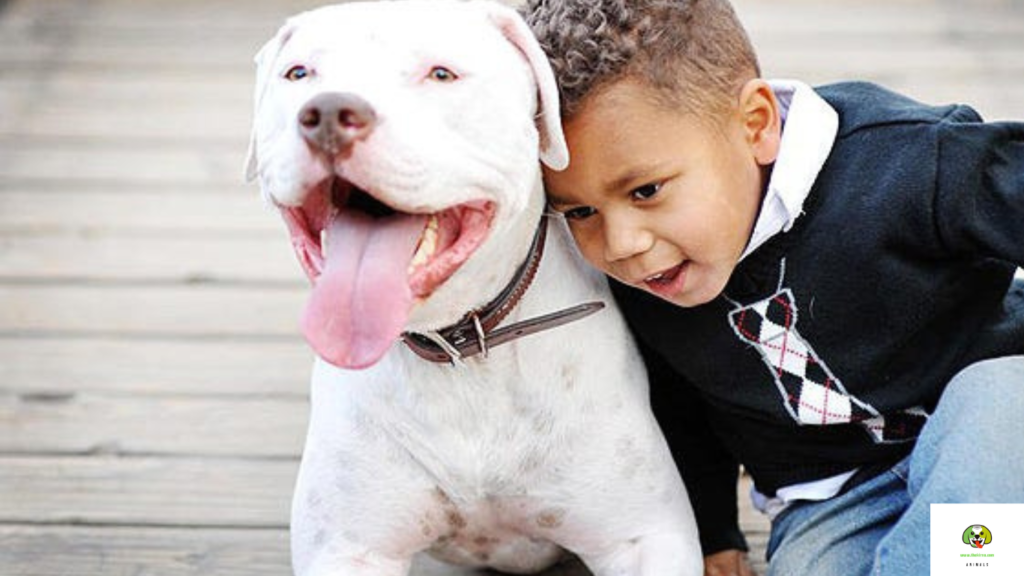
Socialization sets the foundation for a dog’s comfort around people. Pitbulls introduced to children, adults, and other pets during their early puppyhood (ideally between 3 and 14 weeks) are far more likely to grow into confident, calm adults.
Positive experiences—like gentle play, exposure to kid-like noises (laughter, crying, or sudden movements), and supervised interactions—teach them that the world is a safe place.
A pitbull raised in isolation or without exposure to kids might feel anxious or unsure in their presence, which can lead to unpredictable reactions. Socialization isn’t a one-time task; it’s an ongoing process that requires patience and consistency.
Training is equally critical. Pitbulls are intelligent, eager-to-please dogs, but they’re also strong and energetic. Obedience training helps them understand boundaries, like not jumping on small children or grabbing toys too roughly.
Positive reinforcement—using treats, praise, or play as rewards for good behavior—builds trust and encourages cooperation. Harsh training methods, on the other hand, can create fear or aggression. Commands like “sit,” “stay,” and “leave it” are especially useful in households with kids, as they give owners control in unpredictable situations.
Training isn’t just for the dog, either—teaching children how to respectfully interact with the dog (e.g., not pulling ears or bothering them while eating) is part of the equation.
The environment a pitbull grows up in shapes their behavior more than genetics. Dogs raised in chaotic, neglectful, or abusive homes are more likely to develop fear-based behaviours, regardless of breed.
A stable, loving environment with clear routines helps pitbulls feel secure. For example, a dog that’s included in family activities, given mental stimulation (like puzzle toys), and has a quiet space to retreat to when overwhelmed is far more likely to be relaxed around kids.
Consistency matters—mixed signals from family members or unpredictable schedules can confuse a dog and heighten stress.
Finally, individual personality can’t be overlooked. Just like people, every dog has unique traits. Some pitbulls are naturally gentle and patient, while others may be more energetic or reserved. Factors like genetics, early life experiences, and even health issues (e.g., chronic pain) can influence their demeanor.
This is why it’s so important to spend time with a dog before bringing them into a home with kids. Adopting a puppy? Watch how they react to new stimuli. Rescuing an adult? Ask shelters about their history and observe their behaviour around children.
In the end, labelling an entire breed as “good” or “bad” with kids misses the bigger picture. A pitbull’s behaviour is a reflection of its upbringing, training, environment, and unique personality. With the right care, many pit bulls thrive in families—they’re known for their loyalty and affection. But it’s up to owners to put in the work to create a safe, happy dynamic between their dog and their children.
Pitbulls and Kids: Success Stories
Pitbulls have often been misunderstood due to their strong build and history as working dogs, but in reality, they can be incredibly loving and protective family pets. The question “Are Pitbulls good with kids?” The question is quite common, and the response primarily depends on how the dog is raised, trained, and socialized. Many families across the world have heartwarming stories of Pitbulls forming deep bonds with children, proving that these dogs are not just loyal but also gentle and affectionate.

One such success story is of a Pitbull named Sparky, also known as @WalmartSparky on Instagram. Sparky became an internet sensation due to his loving and playful nature with kids. His owners regularly share videos of him cuddling, playing, and even patiently allowing toddlers to climb on him. This is a testament to how well-trained and socialized Pitbulls can be perfect companions for children.
There are also countless viral videos of Pitbulls acting as guardians for babies, standing watch near cribs, or gently nudging toddlers to keep them safe. Many parents have reported that their Pitbulls are not just pets but also their children’s best friends. These dogs are known for their high energy and playful nature, making them excellent playmates for active kids.
A well-trained Pitbull can be extremely protective of its family, often forming an unbreakable bond with children. Their strong sense of loyalty and love ensures that they become not just pets but lifelong companions. Of course, like any breed, responsible ownership is key. Early socialization, proper training, and supervision are essential to ensuring a well-behaved dog.
So, are Pitbulls good with kids? Absolutely—when raised in a loving and structured environment, they can be among the most affectionate and protective family dogs. Their reputation may still face challenges, but real-life stories and testimonials prove that Pitbulls, with the right upbringing, can be gentle, playful, and incredibly devoted to their human families.
| Pros | Cons |
| Can be good with children | They are sturdy so may be difficult for small children to handle |
| Smart and quick learner | High energy levels, which requires daily exercise |
| Very loyal and loving | Wrong training can lead to aggression |
| Good Guard Dogs for Security | Sometimes negative media images create misconceptions in society |
Safety Tips for Families
Pitbulls, like any dog breed, can thrive in homes with kids when families prioritize safety, education, and mutual respect. While their loyalty and affectionate nature make them wonderful companions, it’s essential to create a safe environment for both children and dogs. Here are practical, family-friendly tips to ensure harmony and happiness in your household.
Supervision Is Non-Negotiable
Never leave young children and dogs—regardless of breed—unattended. Kids may unintentionally pull ears, tug tails, or startle a dog with sudden movements, and even the gentlest dog can react unpredictably. Supervision isn’t about distrusting your Pitbull; it’s about preventing accidents before they happen. Think of it like watching toddlers play near a pool—vigilance keeps everyone safe. Encourage calm interactions, and step in if playtime gets too rowdy. A simple “Let’s give Buddy some space!” can redirect energy positively.
Teach Kids to Respect Boundaries
Children need to learn that dogs aren’t toys. Teach them to avoid disturbing a dog while they’re eating, sleeping, or chewing a bone. Explain that climbing on a dog, poking them, or invading their crate is off-limits. Role-play gentle petting (like stroking the back, not the face) and use phrases like “Ask first!” before approaching. Kids often mirror adult behavior, so model kindness and patience. For example, if your Pitbull walks away, say, “He needs quiet time now—let’s read a book instead!”
Learn to Spot Stress Signals
Dogs communicate discomfort through body language, and recognizing these signs can prevent tense situations. A stressed Pitbull might yawn excessively, lick their lips, avoid eye contact, or tuck their tail. Raised hackles (the fur along their back), whale eeyes(showing the whites of their eyes), or freezing in place are also red flags. Teach older kids these cues: “If Bella turns her head away, she’s saying she needs space.” Remind them that even a tolerant dog has limits—never assume “he doesn’t mind.”
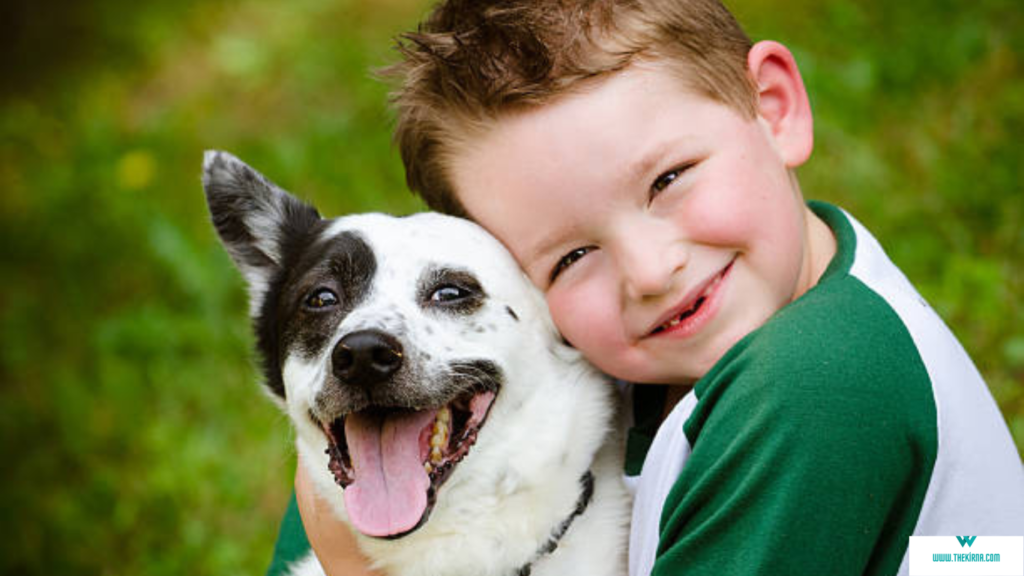
Choose Adoption Wisely
If you’re bringing a Pitbull into a home with kids, opt for a dog with a known history of kid-friendliness. Shelters and rescues often assess temperament—ask about a dog’s behavior around children, noise sensitivity, and energy levels. Meet the dog multiple times before adopting, and involve the whole family in the process. Puppies may seem like a blank slate, but their adult personality can be unpredictable. An adult dog with a calm, patient demeanor might be a safer fit. If adopting a puppy, commit to early socialization and training.
Final Thoughts
Creating a safe, loving bond between kids and Pitbulls starts with preparation and empathy. By supervising interactions, teaching respect, understanding canine communication, and making informed adoption choices, families can build trust and joy. Remember, every dog is an individual—focus on your Pitbull’s unique personality, and celebrate the moments when your furry friend becomes your child’s most loyal protector and playmate.
Addressing Concerns
When discussing whether Pitbulls are good with kids, it’s important to address common worries head-on while providing balanced, fact-based insights. Let’s unpack some key concerns to help families make informed decisions.
Understanding the Numbers
Bite and attack statistics involving Pitbulls often dominate headlines, but these numbers rarely tell the full story. Data on dog bites is frequently skewed by misidentification (many dogs labelled as “Pitbulls” are mixed breeds or not Pitbulls at all) and inconsistent reporting. While no breed is entirely risk-free, studies suggest that a dog’s behaviour is far more influenced by upbringing, training, and environment than genetics alone.
For example, a well-socialized Pitbull raised with love and structure is statistically unlikely to show aggression. Conversely, any breed—from Chihuahuas to German Shepherds—can develop behavioural issues if neglected, abused, or improperly trained. The takeaway? Owner responsibility matters more than breed stereotypes.
The Role of Responsible Ownership
Pitbulls thrive in environments where owners prioritize their physical and emotional needs. Spaying or neutering, for instance, can reduce territorial or dominance-related behaviours, creating a calmer household dynamic.
Regular vet check-ups are equally critical to address health issues that might indirectly affect behaviour (e.g., pain from untreated conditions). Exercise is another non-negotiable—Pitbulls are energetic dogs bred for stamina, and pent-up energy can lead to restlessness or frustration. Daily walks, playtime, and mental stimulation (like puzzle toys or training sessions) are essential.
Socialization is also key: exposing a Pitbull to children, strangers, and other animals from puppyhood helps them grow into confident, adaptable adults. A responsible owner doesn’t just “have” a Pitbull—they actively nurture a happy, well-rounded companion.
When a Pitbull Might Not Be the Right Fit
While many Pitbulls coexist peacefully with kids, there are scenarios where caution is warranted. Families with very young children or limited time to invest in training might struggle with the breed’s high energy levels. A boisterous, untrained Pitbull could accidentally knock over a toddler during play, for example.
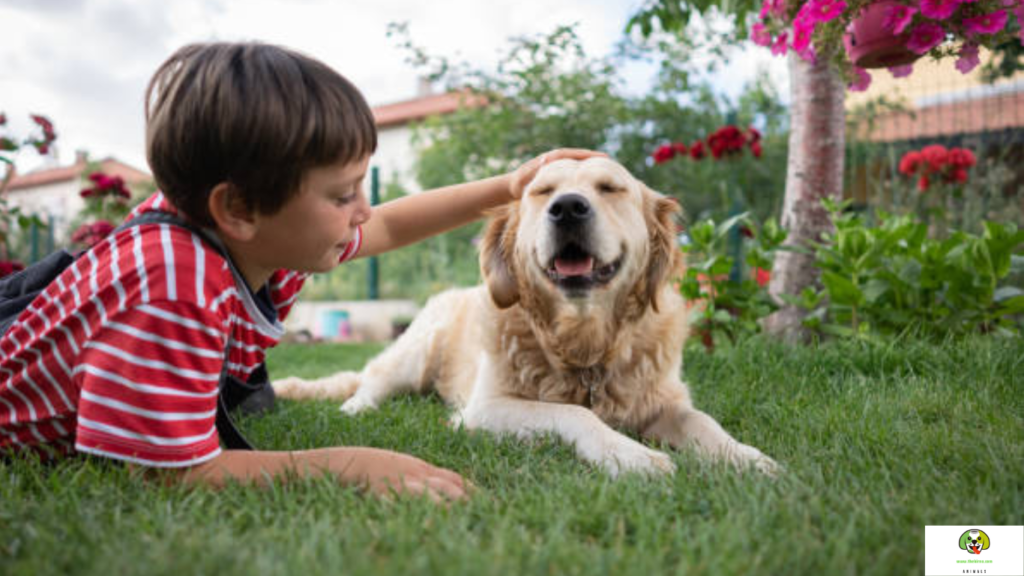
Similarly, rescue dogs with a history of trauma or abuse may require extra patience and professional guidance to overcome fear-based reactions. Adopting a dog with an unknown background? Work with shelters or behaviourists to assess compatibility.
Lastly, households that can’t commit to consistent boundaries (e.g., allowing kids to pull ears or climb on the dog) might be better suited to a lower-energy breed. It’s not about the dog being “bad”—it’s about matching lifestyles and ensuring everyone’s safety.
In short, Pitbulls can be wonderful with kids, but success hinges on honest self-assessment as a family and a commitment to responsible care. Like any relationship, it’s a two-way street: the dog’s needs matter as much as the family’s expectations. When in doubt, consult trainers, vets, or breed-specific rescues to guide your decision.
Conclusion
The question “Are Pitbulls good with kids?” doesn’t have a one-size-fits-all answer—but the truth is, Pitbulls can be incredible family companions when raised with love, structure, and responsibility. Like any dog, their behaviour is shaped by their environment, training, and the care they receive.
When socialized early, given consistent boundaries, and treated with kindness, Pitbulls often show remarkable loyalty, patience, and affection toward children. Their playful energy and protective instincts can make them wonderful playmates and guardians, but it’s up to humans to guide those traits positively.
However, this potential doesn’t happen by accident. Proper training is non-negotiable—for both the dog and the kids. Teaching children how to interact respectfully with pets (no tail-pulling or roughhousing) is just as important as teaching Pitbull obedience and calmness.
If you’re considering bringing a pit bull into your home, adoption is a beautiful place to start. Many shelters are filled with loving Pitbulls waiting for a second chance, and adopting helps break the cycle of stigma surrounding the breed.
Let’s also challenge the outdated stereotypes. A dog’s behaviour isn’t predetermined by their breed but by how they’re raised and treated. Pitbulls, like all dogs, thrive in homes where they feel safe, understood, and valued.
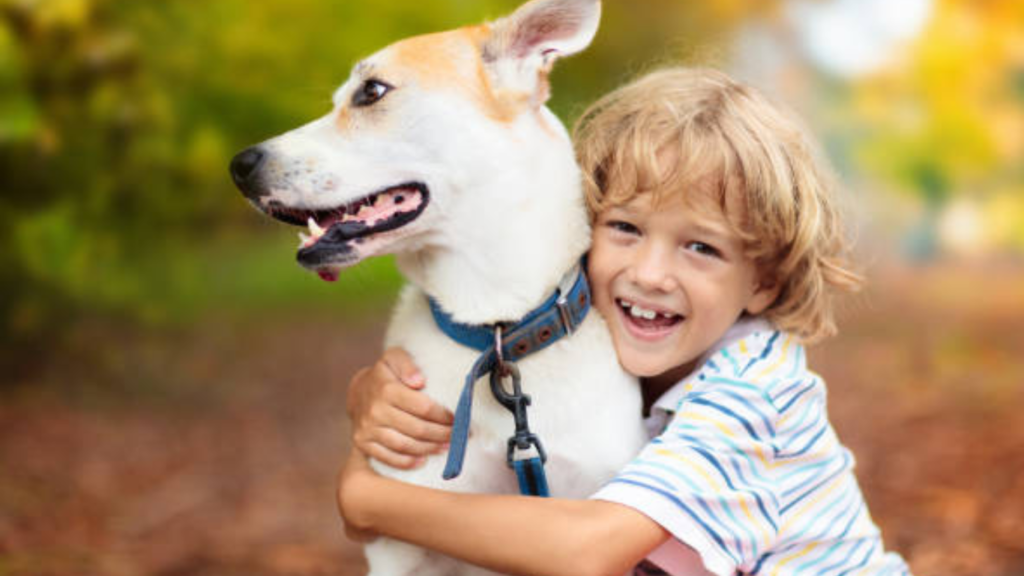
So, if you’re open-minded, committed to responsible ownership, and ready to put in the work, you might just find a furry best friend who’s great with kids—and so much more.
As the saying goes, “A good dog isn’t defined by breed—it’s defined by love and care.” Let that be the lesson we carry forward, one wagging tail at a time.
Read Others Also
Top 10 best dog breeds for protection and family 2025
Why Does My Dog Always Want My Food? Decoding Canine Cravings
Should I get a dog or cat? Here’s How to Know Which One’s Right for You
FAQ
-
Can a pitbull be a house dog?
Absolutely! Pitbulls can thrive as loving, loyal house dogs. Known for their affectionate nature, they bond closely with families and enjoy being indoors. Like any breed, their behaviour depends on upbringing—proper training, socialization, and consistent routines are key. Pitbulls are energetic, so daily exercise and mental stimulation help them stay calm indoors.
Responsible ownership, including positive reinforcement and early socialization, ensures they adapt well to home life. While stereotypes exist, well-raised pit bulls are gentle, playful, and great with kids (under supervision). Every dog is an individual—focus on their needs, and they’ll make wonderful, devoted companions in a household setting.
-
Are pitbulls high maintenance?
Pitbulls aren’t inherently high-maintenance, but they do have specific needs. Their energy levels demand daily exercise (walks, playtime) to stay happy and calm. Their short coat is easy to groom—just occasional brushing. Training and socialization are crucial to nurture their friendly, adaptable nature.
Mental stimulation (toys, puzzles) prevents boredom. While they thrive on attention and companionship, they’re low-maintenance compared to breeds needing constant grooming or extreme activity. With love, structure, and engagement, they fit well into most households without excessive demands.
-
Is Pitbull a friendly dog?
Pitbulls, like any dog breed, can be friendly and affectionate when raised with care, proper training, and socialization. Their temperament depends heavily on their upbringing, environment, and how they’re treated by humans. Many Pitbulls are known for being loyal, playful, and great with families when nurtured responsibly.
Unfortunately, negative stereotypes often overshadow their true nature due to misconceptions or irresponsible ownership. Always judge a dog by its individual behaviour, not its breed. With love, patience, and positive reinforcement, Pitbulls can thrive as loving companions. Responsible ownership is key to fostering a happy, well-adjusted pet.
-
What is a good lifespan for a Pit Bull?
A healthy Pit Bull typically lives 12-14 years, though some reach 15+ with great care. Genetics, diet, exercise, and regular vet checkups play big roles. Keep them at a healthy weight to avoid joint issues, provide mental stimulation, and address breed-specific concerns like skin allergies or heart conditions early.
Responsible breeding also impacts longevity. With love, proper care, and a safe environment, Pit Bulls can enjoy a full, vibrant life as loyal companions. Regular preventive care is key to catching health issues before they become serious.


Трансформация пространства с помощью дизайнерской мебели.
Дизайнерская мебель премиум-класса http://www.byfurniture.by/ .